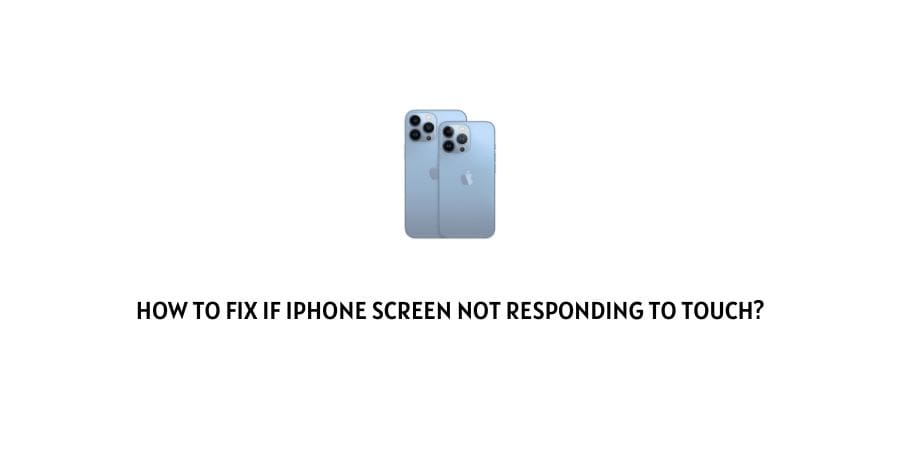
The exqusite touchscreen interface is what sets your iPhone apart. An iPhone is pretty much worthless if the touchscreen doesn’t function.
Unfortunately, the touch screen of an iPhone can sometimes cease responding to touch; however, this is a rare occurrence.
On the plus side, if you haven’t dropped your phone or gotten it wet before the symptoms begin, you have a better chance of having it fixed.
However, if you’re unaware of how to fix iPhone screen not responding to touch, we’ve got your back.
In this article, you’ll discover some of the finest solutions to fix iPhone screen touch issues. Let’s get into the details!
Why iPhone Screen Not Responding to Touch?
When this happens, either the hardware component of your iPhone’s display responsible for processing touches stops functioning properly or the software component of your iPhone stops communicating with the hardware as it should.
If you’ve recently dropped your iPhone, the touch screen may malfunction because of a hardware issue.
Applications that run slowly or have persistent problems almost always have a root cause in the program itself.
Finally, remember that a screen protector might hinder your iPhone’s touch screen from working properly.
If the touchscreen on your iPhone is not responding to touch, try taking off the screen protector.
How to Fix iPhone Screen Not Responding to Touch?
Looking for methods to fix the iPhone screen not responding to touch? You’ll find the answers in this section.
Without a responsive screen, your iPhone might become useless. However, you can fix the problem by using the following methods:
Fix 1. Force Restart iPhone
A force restart is another way to fix the iPhone screen not responding to touch. You should wait a minute or two after a forced restart and then try turning on your iPhone again. A frozen iPhone screen may become functional after restart because it clears any memory issues.
To attempt a force restart on your iPhone, follow these guidelines:
- iPhone 6s and Earlier: Until the Apple logo doesn’t appear, press and hold the Power and Home buttons simultaneously.
- iPhone 7 and 7+: Hold the power button until you can see the Apple logo, then press the Volume up or down button.
- iPhone 8 and later: The Volume Up button must be pressed and released rapidly. Then, rapidly press the Volume Down button and let go. When you get the Apple logo, release the Power button.
Fix 2. Factory Reset Your iPhone
The next thing you should try is factory resetting your iPhone. However, you should be aware that resetting your iPhone to factory settings will remove all your data. There is a distinction between data deletion and a factory reset.
When you delete anything from your iPhone, it still lives on your device, but when you do a factory reset, everything is deleted forever.
You should back up your iPhone before doing a factory reset in case you accidentally delete something.
To do a factory reset on your iPhone, follow these steps:
Step 1: On your iPhone, tap on the Settings app and navigate to General
Step 2: Scroll down to Transfer or Reset iPhone and tap on it. Now, hit Erase All Content and Settings.
Step 3: Now, give the password or FaceID, and tap on Erase ALL Contents and Settings in the popup.
Fix 3: Use System Recovery Tool – TunesKit iOS System Recovery
When it comes to a simple solution with no data loss to fix your iPhone screen issue, you require a high-quality system recovery tool.
Since multiple tools are available, finding the best and most reliable one is quite difficult.
To ease this up, we bring you the best system recovery tool – TunesKit iOS System Recovery.
Without contacting an Apple support representative, you can rapidly resolve any common iOS problem using TunesKit iOS System Recovery.
No matter what state your iOS device is in—whether it’s stuck in recovery mode, DFU mode, the white Apple logo, or a black, frozen, disabled screen—this savvy iOS repair tool will always get you out of the mess and back to normal in no time.
TunesKit iOS System Recovery is more than just a simple iOS repair tool; it can solve various issues. It facilitates rolling back your iOS version to an earlier version.
In addition, you may use this innovative program to repair iTunes errors that may have occurred when attempting to restore or back up the device. More importantly, it can help iPhone exit recovery mode in one click.
Key features
- Restore your iOS device to normal at home without erasing any data.
- Solves common problems with the iOS system, such as the Apple logo, boot loops, and black screens.
- iOS 16 can be downgraded to version 15.6.1 without requiring a jailbreak.
- Fixes your iPhone not responding to touch with simple clicks.
- Perfectly compatible with the most recent version of iOS 16 and iOS devices.
To fix your iPhone screen not responding to your touch via iTunes iOS System Recovery, follow the steps below:
Step 1: Go to the TunesKit official site and download and install TunesKit iOS System Recovery on your PC. After that, launch the tool and click on Start. Ensure the iPhone is connected to PC via a USB cable.
Step 2: Now, the interface will ask you to select a mode from the two available ones, i.e., Standard Mode and Advanced Mode. Select Standard Mode and click on Next to proceed. Now, follow the on-screen instruction to get your iPhone into recovery mode.
Step 3: You will get the firmware package needed to fix the issue on the next screen. Verify the information on your iPhone. If there’s anything wrong, you can correct it. After you’ve verified, click on Download to start downloading the firmware package.
Step 4: After downloading, click on Repair for the system to start repairing your iPhone not responding to touch. Make sure that your iPhone stays connected throughout the process to avoid any possible damage.
Pros
- Solves 150+ iOS issues
- User-friendly interface
- 100% data protection
Cons
- Limited free trial
FAQs | Frequently Asked Questions
Yes, TunesKit iOS System Recovery offers a free trial version that all users may use to test the software’s functionality and determine whether their devices are compatible.
Standard Mode should be used first to resolve your iOS problem because it can resolve typical system issues without causing data loss. If your issue is still not fixed, you can attempt Advanced Mode. However, it will wipe your device’s data.
Yes, it is completely safe to use. TunesKit iOS System Recovery for Windows and Mac is free of unwanted viruses, spyware, or other issues. There will be no personal information collection, ensuring 100% data privacy.
Conclusion
Although iPhone, the most used smartphone in the world, is greatly manufactured, it sometimes runs into issues.
One of those issues is having an iPhone screen not respond to touch, which is quite frustrating.
However, we hope that you know how to fix iPhone screen not responding to touch after reading this article.
Moreover, our top recommendation for solving this issue is TunesKit iOS System Recovery since it is a one-stop solution for all your iOS problems.
Like This Post? Checkout More
